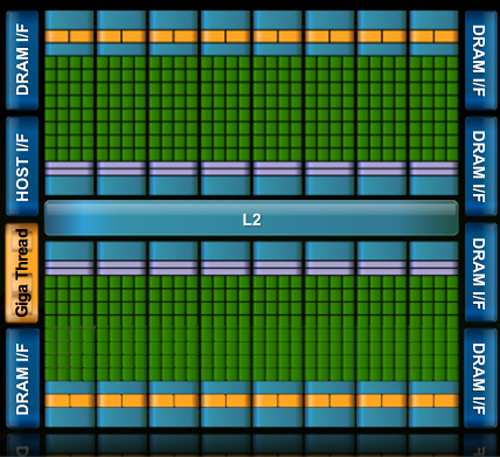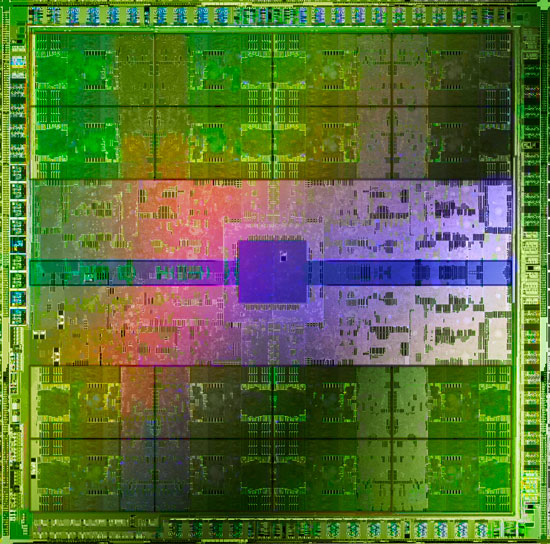At this year’s Consumer Electronics Show, NVIDIA had several things going on. In a public press conference they announced 3D Vision Surround and Tegra 2, while on the showfloor they had products o’plenty, including a GF100 setup showcasing 3D Vision Surround.
But if you’re here, then what you’re most interested in is what wasn’t talked about in public, and that was GF100. With the Fermi-based GF100 GPU finally in full production, NVIDIA was ready to talk to the press about the rest of GF100, and at the tail-end of CES we got our first look at GF100’s gaming abilities, along with a hands-on look at some unknown GF100 products in action. The message NVIDIA was trying to send: GF100 is going to be here soon, and it’s going to be fast.

Fermi/GF100 as announced in September of 2009
Before we get too far ahead of ourselves though, let’s talk about what we know and what we don’t know.
During CES, NVIDIA held deep dive sessions for the hardware press. At these deep dives, NVIDIA focused on 3 things: Discussing GF100’s architecture as is relevant for a gaming/consumer GPU, discussing their developer relations program (including the infamous Batman: Arkham Asylum anti-aliasing situation), and finally demonstrating GF100 in action on some games and some productivity applications.
Many of you have likely already seen the demos, as videos of what we saw have already been on YouTube for a few days now. What you haven’t seen and what we’ll be focusing on today, is what we’ve learned about GF100 as a gaming GPU. We now know everything about what makes GF100 tick, and we’re going to share it all with you.
With that said, while NVIDIA is showing off GF100, they aren’t showing off the final products. As such we can talk about the GPU, but we don’t know anything about the final cards. All of that will be announced at a later time – and no, we don’t know that either. In short, here’s what we still don’t know and will not be able to cover today:
- Die size
- What cards will be made from the GF100
- Clock speeds
- Power usage (we only know that it’s more than GT200)
- Pricing
- Performance
At this point the final products and pricing are going to heavily depend on what the final GF100 chips are like. The clockspeeds NVIDIA can get away with will determine power usage and performance, and by extension of that, pricing. Make no mistake though, NVIDIA is clearly aiming to be faster than AMD’s Radeon HD 5870, so form your expectations accordingly.
For performance in particular, we have seen one benchmark: Far Cry 2, running the Ranch Small demo, with NVIDIA running it on both their unnamed GF100 card and a GTX285. The GF100 card was faster (84fps vs. 50fps), but as Ranch Small is a semi-randomized benchmark (certain objects are in some runs and not others) and we’ve seen Far Cry 2 to be CPU-limited in other situations, we don’t put much faith in this specific benchmark. When it comes to performance, we’re content to wait until we can test GF100 cards ourselves.
With that out of the way, let’s get started on GF100.











115 Comments
View All Comments
Zool - Tuesday, January 19, 2010 - link
There are still plenty of questions.Like how tesselation efects MSAA with increased geametry per pixel. Also the flat stairs in uniengine (and very plastic, realistic after tesselation and displacement mapping), would they work with collision detection as after tesselation or before as completely flat and somewhere else in the 3d space. The same with some physix efects. The uniengine heaven is more of a showcase of tesselation and what can be done than a real game engine.
marraco - Monday, January 18, 2010 - link
Far Cry Ranch Small, and all the integrated benchmark, reads constantly the hard disk, so is dependent of HD speed.It's not unfair, since FC2 updates textures from hard disk all the time, making the game freeze constantly, even in the better computers.
I wish to see that benchmark run with and without SSD.
Zool - Monday, January 18, 2010 - link
I want also note that for the stream of fps/3rd person shooters/rts/racing games that look all same sometimes upgrading the graphic card doesnt have much sense these days.Can anyone make a game that will use pc hardware and it wont end in running and shoting at each other from first or third person ? Dragon age was a quite weak overhyped rpg.
Suntan - Monday, January 18, 2010 - link
Agreed. That is one of the main reasons I've lost interest in PC gaming. Ironically though, my favorite console games on the PS3 have been the two Uncharted games...-Suntan
mark0409mr01 - Monday, January 18, 2010 - link
Does anybody know if Fermi, GF100 or whatever it's going to be called have support for bitstream of HD audio codecs?Also do we know anything else about the video capabilites of the new card, there doesn't really seem to have been much mentioned about this.
Thanks
Slaimus - Monday, January 18, 2010 - link
Seeing how the GF100 chip has no display components at all on-chip (RAMDAC, TMDS, Displayport, PureVideo), they will probably be using a NVIO chip like the GT200. Would it not be possible to just put multiple NVIO chips to scale with the number of display outputs?Ryan Smith - Wednesday, January 20, 2010 - link
If it's possible, NVIDIA is not doing it. I asked them about the limit on display outputs, and their response (which is what brought upon the comments in the article) was that GF100 cards were already too late in the design process after they greenlit Surround to add more display outputs.I don't have more details than that, but the implication is that they need to bake support for more displays in to the GPU itself.
Headfoot - Monday, January 18, 2010 - link
Best comment for the entire page, I am wondering the same thing.Suntan - Monday, January 18, 2010 - link
Looking at the image of the chip on the first page, it looks like a miniature of a vast city complex. Man, when are they going to remake “TRON”……although, at the speeds that chips are running now-a-days, the whole movie would be over in a ¼ of a second…
-Suntan
arnavvdesai - Monday, January 18, 2010 - link
In you conclusion you mentioned that the only thing which would matter would be price/performance. However, from the article I wasnt really able to make out a couple of things. When NVIDIA says they can make something look better than the competition, how would you quantify that?I am a gamer & I love beautiful graphics. It's one of the reasons I still sometimes buy games for PCs instead of consoles. I have a 5870 & a 1080p 24" monitor. I would however consider buying this card if it made my game look better. After a certain number(60fps) I really only care about beautiful graphics. I want no grass to look like paper or jaggies to show on distant objects. Also, will game makers take advantage of this? Unlike previous generations game manufacturers are very deeply tied to the current console market. They have to make sure the game performs admirably on current day consoles which are at least 3-5 years behind their PC counterparts, so what incentive do they have to try and advance graphics on the PC when there arent enough people buying them. I am looking at current games and frankly just playing it, other than an obvious improvement in framerate, I cannot notice any visual improvements.
Coming back to my question on architecture. Will this tech being built by Nvidia help improve visual quality of games without additional or less additional work from the game manufacturing studios.